The 2-44th “Strike Fear” Air Defense Artillery Battalion conducted Live Fire Training last Tuesday
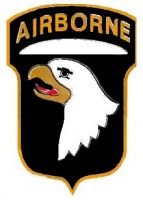 For the military, training is a deadly serious matter: the mission is, as they say, job one. That’s why when the men of the 2-44th “Strike Fear” Air Defense Artillery Battalion, 101st Sustainment Brigade needed to re-certify their gunners’ abilities with the Avenger weapons system; it became an entire unit operation involving the command staff, security teams, gunners, supply clerks, cooks, and medics.
For the military, training is a deadly serious matter: the mission is, as they say, job one. That’s why when the men of the 2-44th “Strike Fear” Air Defense Artillery Battalion, 101st Sustainment Brigade needed to re-certify their gunners’ abilities with the Avenger weapons system; it became an entire unit operation involving the command staff, security teams, gunners, supply clerks, cooks, and medics.
Recent snows had turned the gravel range roads into a muddy mess dotted with puddles and gaping potholes. That made our little convoy of media undergo an ordeal of our own while driving back to the remote range.
Arriving at the location of the training, we were halted at a barbed wire check point manned by armed sentries. They radioed our arrival to their command team, and after a short wait, they moved the barbed wire, and we were allowed to pass.
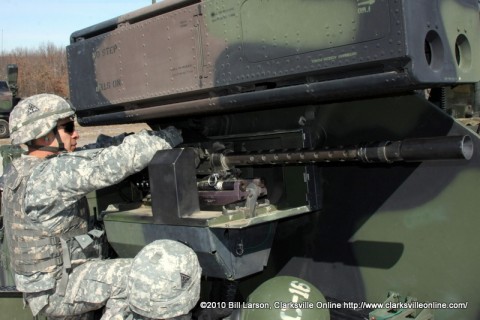
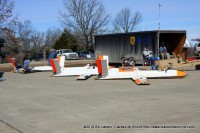
The first thing we see is a line of drone aircraft lined up on a little concrete pad with a compressed air launcher. Two men from Griffon Aviation were getting one ready for launch. These nimble little aircraft were to be the targets the gunners would attempt to hit.
The Public Affairs Officer, PFC Denham, brought over the Commander of Charlie Battery, Captain Nathan Minott. He stated that their mission was “Improving unit efficiency, and ensuring that the soldiers were trained on their weapons system.” His words were interspersed with occasional bursts of gunfire as units on the firing line conducted their training.
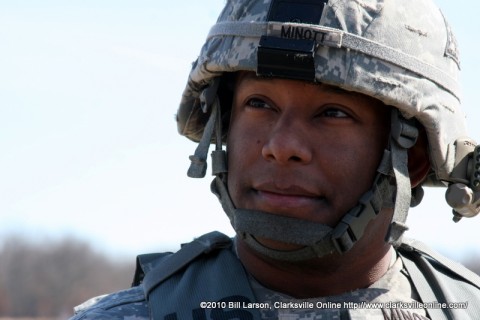
One of the issues identified early on was maintenance problems that resulted from the fact that the lack of enemy air-power means that these systems were not getting used during the unit’s Afghanistan deployments. The unit had been more involved in providing counter battery support and security and detainee operations. However, as Capt. Minott pointed out, “The maintenance teams are doing a great job correcting the issues as they are detected.”
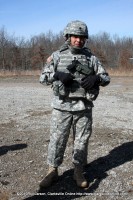
Lt. Col. Tom Nguyen, the Battalion commander, spoke with us next. He identified drones like the ones being targeted on this day, as the main threat that the unit was expected to face in the future. “These things are cheap, and everyone has them,” he said. “Unmanned drones are capable of doing everything from aerial surveillance to launching weapons at our troops.”
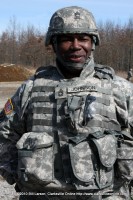
SFC. Timothy Johnson stressed the importance of the training. For many of the soldiers, this was the first time they have live fired these weapons. “It is important that the soldiers understand how their weapons system works.”
We moved on to speak with SSG. Andres Ibarra, who was in charge of the munitions bunker. He said that they had to move over 25,000 rounds of ammunition to the range for the training exercise. They were going through approximately 7,000 rounds per day. Each gunner was shooting a 25-50 round burst, and this would be repeated multiple times until they had fired 500 rounds. The barrels in the weapons have to be swapped out after approximately 1,000 rounds have been fired.

We made a quick visit to the on-site headquarters, which was getting prepared for a staff meeting.
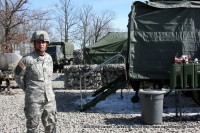
Next we met with SSG. Thomas Martin at the mess area. They had a portable kitchen that makes enough food to feed the entire company. SSG Thomas had 30 years of cooking experience and had been cooking for the Army for 15 years.
“There are several types of meals,” he said. “UGRS, Fresh Food, MRE’s, and Heat and Serve”’ Asked if Army food was as bad as people joked, he said “It’s all in what you do with it.” While we were there, PVT Andrés Lopez was in the process of cooking cheese burgers, and they looked delicious. Outside, some soldiers were grabbing a quick snack of fresh apples and oranges.
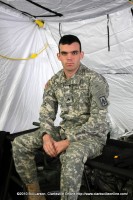
At the Battery headquarters, personnel were coordinating the live fire exercise, keeping track of who did what and when. Also located there was a small first aid station where SGT. James Moreo was waiting to deal with any injuries resulting from the training. He said the situations they deal with range from people with colds and sniffles to soldiers with cuts, burns, and even smoke inhalation, which can result from every day operations on these weapons.
An observation tower housing the range safety officers overlooked the firing line. The Avengers were positioned on the firing line when they were ready to go though their paces. The soldiers fired the weapons from both inside the vehicle and via a nearby remote control station.

The training was limited to the machine guns only. The Stingers couldn’t be fired due to the size of the range at Fort Campbell. Stingers require a range area of 25 miles wide by 25 miles deep, and the Fort Campbell Ranges are not that big.
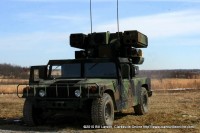
There were several targets ranging from vehicles located down range to the fast moving drone aircraft, and the soldiers took turns shooting at each. One of the soldiers had managed to hit the nimble drones at least 17 times.
While not currently scheduled for deployment, this unit is on call and can be deployed for combat duty at any time. We can sleep easy knowing that men with this level of dedication stand ready to keep us safe.


























